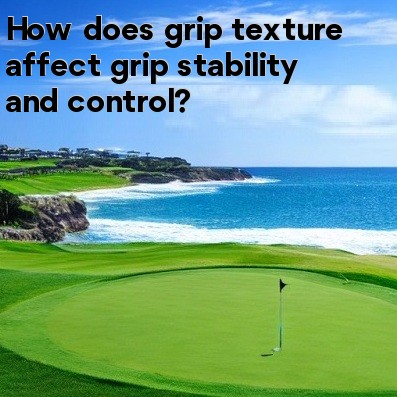
Grip Texture and its Impact on Stability and Control in Golf
Golf is a sport that requires a strong and stable grip on the club to ensure maximum control over the swing. One often overlooked aspect of the grip is the texture of the grip itself. The texture of the grip plays a crucial role in determining how stable and controlled a golfer's grip is during the swing. Let's explore how grip texture affects grip stability and control in golf.
- Enhanced Traction: One of the primary benefits of a textured grip is the enhanced traction it provides. A grip with a textured surface allows the golfer's hands to firmly hold onto the club, reducing the chances of slipping or losing control during the swing. The texture acts as a gripping agent, promoting a more secure hold and preventing unnecessary movement of the hands.
- Better Sweat Absorption: Golf is a physically demanding sport, and players often find themselves sweating during the game. This sweat can make the hands slippery and impact the stability of the grip. However, grips with added texture are designed to absorb sweat, providing a drier surface for the hands to grip onto. This, in turn, enhances stability and control by reducing the chance of the hands slipping due to sweat.
- Increased Feedback: A textured grip can also provide the golfer with increased feedback during the swing. The texture allows for a better connection between the hands and the club, enabling the golfer to feel the clubhead through the grip. This increased feedback helps in maintaining a consistent grip pressure and can greatly enhance control over the club during the swing. The golfer can sense any slight adjustments needed in their grip and make the necessary changes for a more controlled swing.
- Improves Confidence: The stability and control offered by a textured grip can significantly impact a golfer's confidence on the course. When a golfer feels confident in their grip, they are more likely to swing with greater conviction and focus. A textured grip instills a sense of trust and allows the golfer to execute their shots with more precision and control, ultimately leading to better performance on the course.
In addition to these benefits, grip texture also comes in various patterns and designs, allowing golfers to choose one that suits their personal preference and playing style. Whether a golfer prefers a slightly rougher texture or a softer, tackier feel, they can find grips that cater to their grip preferences.
In conclusion, the texture of a golf grip plays a significant role in determining the stability and control a golfer has over their club. A textured grip enhances traction, absorbs sweat, provides increased feedback, and boosts confidence. These benefits collectively contribute to better grip stability and control, ultimately impacting the golfer's overall performance on the course. So, the next time you're looking to improve your golf game, consider the texture of your grip and choose one that best suits your needs.





